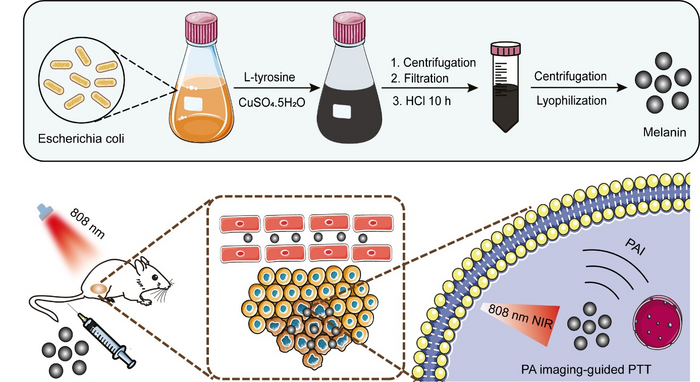A January 13, 2023 news item on phys.org announces research into genetically engineering bacteria so they produce melanin nanoparticles, i.e., biosynthetic melanin nanoparticles, Note: Links have been removed,
Photothermal therapy (PTT) has attracted considerable attention for the treatment of tumors because it is minimally invasive and has spatiotemporal selectivity.
Melanin is a kind of multifunctional pigment found widely in mammals, plants and microbes, with great prospects as a PTT agent for cancer treatment. Unfortunately, commercially available melanin is mainly obtained by chemical synthesis or extraction from sepia, which hinders its large-scale production and causes some potential safety hazards.
Recently, a research team led by Prof. Yan Fei from the Shenzhen Institute of Advanced Technology (SIAT) of the Chinese Academy of Sciences, together with Prof. Lin Jing from Shenzhen University and Prof. Xu Xiaohong from Guangdong Medical University, heterologously expressed a tyrosinase gene in Escherichia coli to synthesize melanin nanoparticles under mild and environmentally friendly conditions.
…

A January 13, 2023 Chinese Academy of Sciences press release (also on EurekAlert but published January 12, 2023), which originated the news item, provides a little more detail about the research,
The biosynthetic melanin nanoparticles exhibited excellent biocompatibility, good stability, and negligible toxicity. “They had strong absorption in the near-infrared region and higher photothermal conversion efficiency (48.9%) than chemically synthesized melanin-like polydopamine nanoparticles under an 808-nm laser irradiation,” said Prof. YAN.
The researchers further evaluated the photoacoustic imaging performance and antitumor efficacy of biosynthetic melanin nanoparticles. The results showed that the biosynthetic melanin nanoparticles had excellent photoacoustic imaging performance and could be used for photoacoustic imaging-guided photothermal therapy in vivo.
“Our study provided an alternative approach to synthesize PTT agents with broad application potential in the diagnosis and treatment of cancer,” said Prof. YAN.
Here’s a link to and a citation for the paper,
Biosynthesis of Melanin Nanoparticles for Photoacoustic Imaging Guided Photothermal Therapy by Meijun Fu, Yuping Yang, Zhaomeng Zhang, Yaling He, Yuanyuan Wang, Chenxing Liu, Xiaohong Xu, Jing Lin, Fei Yan. Small DOI: https://doi.org/10.1002/smll.202205343 First published: 29 December 2022
This paper is behind a paywall.